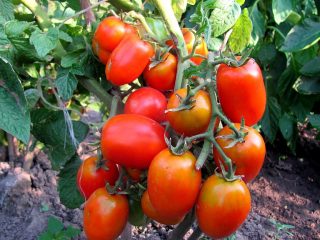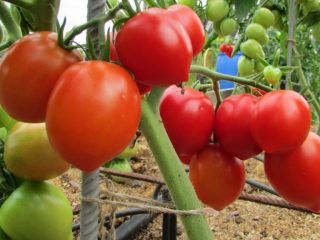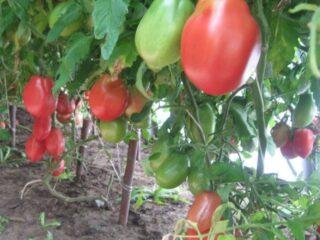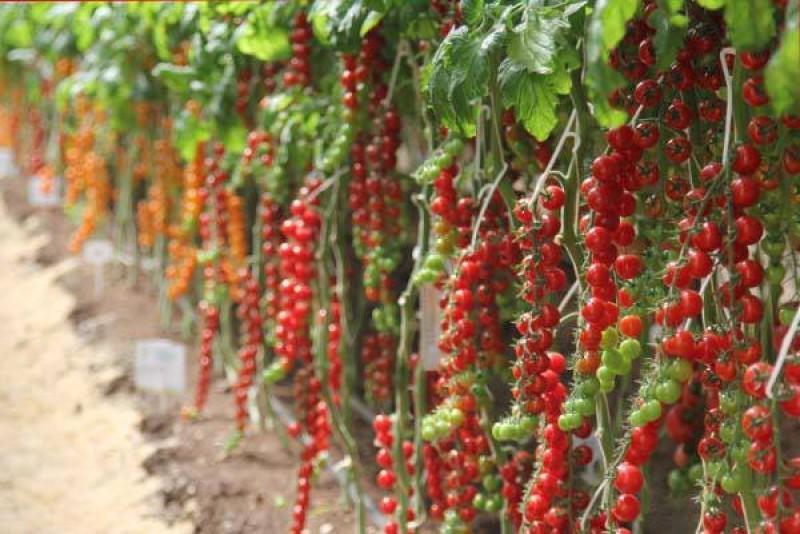Content
Tomato King Aramis is a low-growing, high-yielding variety with flat-round burgundy fruits, the juicy fleshy pulp of which has a pleasant spicy-sweet taste. It is characterized by an extended fruiting period and is suitable for cultivation in open and protected ground.
When and how did it appear
Since the end of the last century, Australian and American breeders have been closely involved in breeding tomatoes that can develop well and bear fruit in a limited space. In fact, they created “indoor” varieties of tomatoes, which in addition pleased with their high productivity and low maintenance requirements. By 2011, breeders managed to develop more than a dozen new varieties of tomatoes that successfully passed variety trials.
Description and characteristics of tomato Dwarf King Aramis
The plant is a low-growing compact bush of determinate type, with a height of 70 cm to 1.2 m. Its stems are densely leafy with simple, wrinkled, regular plates, painted green.
During the fruiting period, fairly large tomatoes are formed on the bush. They are collected in brushes, each of which can contain 4-6 pieces. The fruits are covered with thick skin and have a flat-round shape. They are colored reddish-chocolate with greenish shoulders and have dense burgundy-brown flesh with a pink center. Tomatoes do not ripen for a long time and can hang ripe on the bush.

Depending on the growing method, the weight of King Aramis tomatoes is 150-300 g
Ripening and fruiting
The King Aramis tomato belongs to the mid-early varieties, in which mass harvesting begins 105-115 days after the appearance of the first shoots. It is characterized by an extended fruiting period, lasting until the onset of frost.
Tomato yield King Aramis
The variety is valued for its high productivity. Under favorable conditions and proper agricultural technology, about 2 kg of ripe tomatoes can be harvested from each bush per season.
Disease resistance
The variety is immune to major tomato diseases. It has good immunity to Alternaria, bacteriosis, stolbur and verticillium.
Where is it grown?
King Aramis tomatoes are suitable for cultivation throughout almost the entire territory of Russia. In the south and in the middle zone, the variety can bear fruit both in unprotected and in closed ground.In regions with unfavorable meteorological conditions, these tomatoes are grown in greenhouses. Also, King Aramis tomatoes can be grown in large containers on the balcony. But it won’t be possible to plant them on window sills due to insufficient air circulation.
Purpose and application
Ripe King Aramis tomatoes have juicy, fleshy burgundy-brown pulp that has a pleasant sweet taste with light, spicy notes. Thanks to these characteristics, the variety is actively used in cooking. These tomatoes are eaten raw and used to make vegetable salads, sauces and side dishes. King Aramis tomatoes are also suitable for canning. They make delicious adjika, lecho, chopped winter salads, seasonings and pastes.

King Aramis tomatoes do not lose their beneficial properties during heat treatment and are harmoniously combined with various products
Advantages and disadvantages
The King Aramis tomato is a rare variety and is valued for its exotic color and spicy-sweet taste of the fruit. It is suitable for cultivation throughout the Russian Federation and shows maximum productivity when grown in film greenhouses.

The King Aramis tomato fruits are covered with a dense skin that protects them from cracking and mechanical damage.
Pros:
- pleasant taste;
- versatility;
- rich color;
- high productivity;
- low maintenance requirements;
- crack resistance.
Minuses:
- demands on soil acidity.
Planting dates and scheme
The King Aramis tomato is grown using the seedling method. In most regions, seeds are sown in the second half of March. For sowing, choose seedling cassettes or plastic containers with drainage holes at the bottom to prevent the development of blackleg.
The planting material is first immersed in a glass with a 1% solution of potassium permanganate for half an hour and soaked in a growth stimulator, and then evenly distributed in a container filled with any universal substrate or a mixture of peat and sand in a 1:1 ratio. If tomato seeds are sown too thickly, the seedlings will grow thin and weak.
The crops are sprinkled with a layer of earth no more than 5 mm thick, watered abundantly with non-cold, settled water and covered with glass or transparent film to create a greenhouse effect.
The cover is removed immediately after the sprouts appear. Hatched seedlings are kept at a temperature of about +8-10 0C at night and +10-15 0C day to harden them before planting them in the ground.

If necessary, the sprouts are illuminated with a phytolamp to avoid stretching and thinning of the plants
The strengthened seedlings are transferred to a permanent place at the age of 60-70 days. To do this, choose a flat, well-lit area with neutral or slightly acidic soil and deep groundwater. Typically, tomato seedlings are planted in rows so that neighboring bushes are separated by 25-30 cm, and the row spacing is 50-65 cm. Organic and inorganic fertilizers must be added to the holes. Tomato seedlings are watered abundantly and mulched.
How to care
Although the King Aramis tomato is a picky variety, to obtain a rich harvest and improve the taste characteristics of the fruit, gardeners will have to perform basic agrotechnical manipulations.
The plant needs regular and moderate watering with non-cold, settled water. For the first 10-15 days after transferring to a permanent place, the bushes do not need to be moistened. At this stage, they have enough water added during planting. With the appearance of ovaries, tomatoes are watered once every 5-7 days at the rate of 10 liters of water for each plant.

Experienced summer residents advise using a drip irrigation system to prevent moisture from getting on the leaves and inflorescences
After each watering, the soil under the bushes must be loosened to prevent the formation of a hard crust, which impedes the access of oxygen to the roots. Usually this procedure is combined with weeding the beds and row spacing.
King Aramis tomatoes respond well to organic and mineral fertilizers. They are applied twice a month, alternating with each other.
Due to the compactness of the bushes, this variety of tomatoes does not require pinching. If necessary, plants are formed into 1-2 stems. When growing in regions with strong winds, the bushes are tied to supports to preserve the harvest and prevent shoots from breaking off.
Treatment against diseases and pests
Although the King Aramis tomato is immune to the main “tomato” diseases, under unfavorable conditions it is easily affected by fungi. To prevent infection, the plantings are provided with proper care and regular preventive treatments with broad-spectrum chemicals - Topaz, XOM.
Conclusion
Tomato King Aramis is a compact variety that easily competes with varieties characterized by unlimited bush growth. It is valued for its high productivity and aromatic, spicy-sweet fruits.
Reviews from summer residents about the King Aramis tomato








